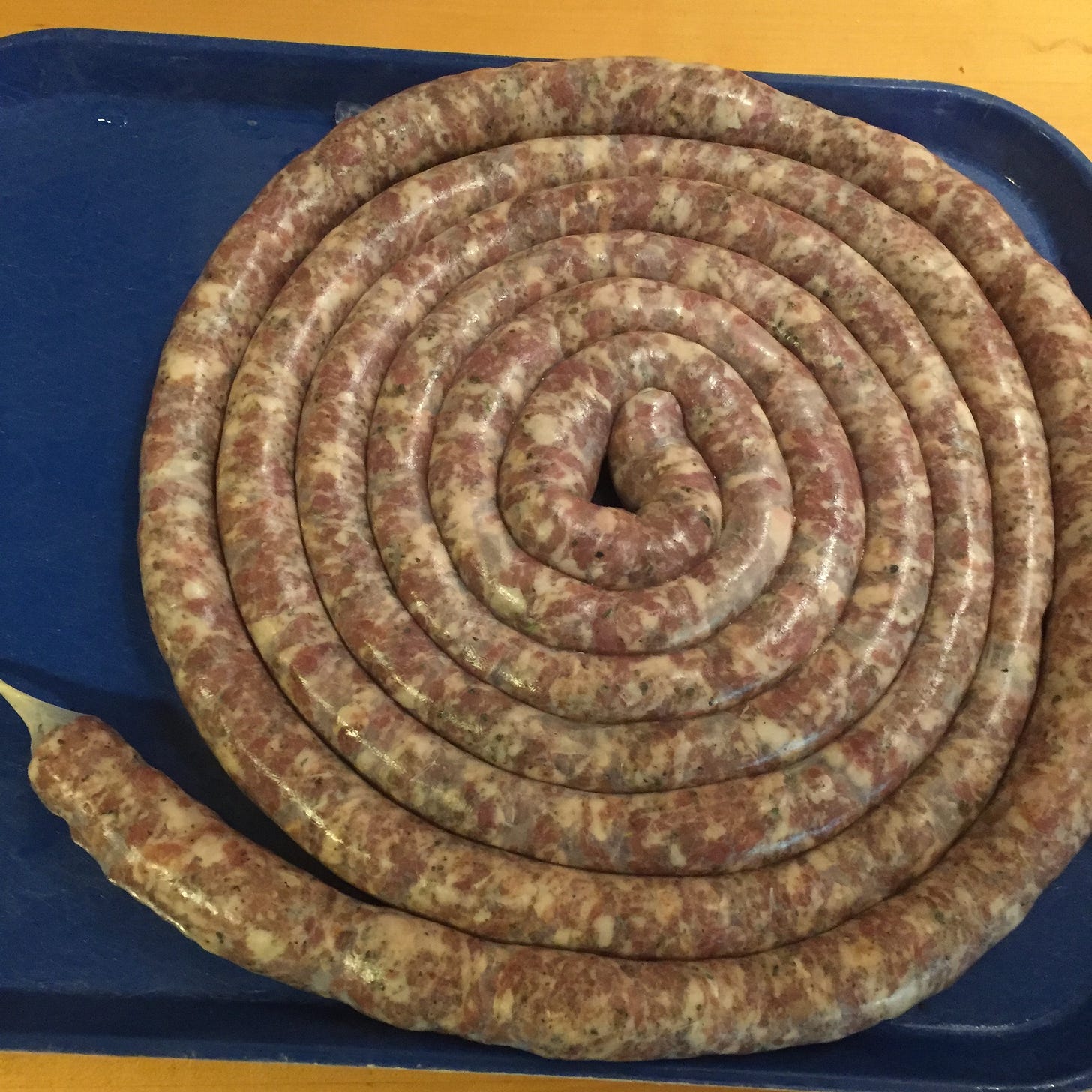Week 8: A Lemony Twist
If your innovation center does not have a stage and a pole, what are you even doing?
Welcome to Sausage Season, the newsletter for people who want to see how the sausage is made. Seeing how the sausage is made is actually the first thing on my heart this week. I have included pictures in my posts so far, but at least with my abilities, making sausage is not very photogenic. I would welcome your thoughts.
More generally, there were some things I failed to consider when I set an intention to do a weekly charcuterie newsletter. I had not planned on breaking any ribs, let alone five, of my own. It’s slowed me down. Also, as we get into doing more actual cured meats, we are dealing with something that is narratively and visually Not Compelling, in that watching a sausage lose 30% of its weight is darn close to watching paint dry.
Also! There are TV shows — the X files come to mind — where there are episodes that are self-contained, and those that are part of a longer narrative arc. So far, we’ve done projects that are one and done, which fits the structure of the newsletter pretty well. As we move toward planned projects like pepperoni or guanciale with longer curing times, they will stretch out over several weeks. As such, there might be a future for this newsletter where there are several overlapping narratives, like a Russian novel, or an episode of Blue Bloods. Again, I welcome your thoughts on how to manage this challenge.
This week, we return to my sausage standby, the Slender James, which is my iteration of the saucisson sec recipe in the Ruhlman Charcuterie book. Once again, if you want to start making sausages, this is the most reliable and user friendly book I have encountered. The name comes from Slim Jims, but these are fancier, and thus Slim Jims. (Fancier in this case means “not made with mechanically separated chicken.”) I have probably made this recipe in different variations close to 100 times. Something that I think that is underrated in cooking is the mindset it takes to keep doing something and getting slightly better at it. The first time I made this recipe, I remember it took me so long that I watched an entire season of Longmire while making them, and still went to bed with the kitchen a complete disaster.
Part of what kept me up so late that first time was that I was making them like this.
(These are a slightly larger sausage, but Ruhlman suggests that you should twist between each individual link as you stuff the casing. I was never very good at this part. What I figured out fairly quickly is that you can stuff it continuously, like this,
and then cut into lengths, and hang to dry, either in the mudroom (VT), or in a specially modified trash can (SC).
The little one on the left has a date and starting weight, so you can check and see when it has lost 30% of its starting weight, which is when it is ready/safe to eat. Then you cut into lengths that are the length of the short side of a baking soda box, or just eyeball.
There are three basic stages - mise, grind, and stuff. If you are trying to work in some weeknight sausage making, you can do the steps on separate nights. If you have a helper like my friend Blueberry, who is ten, you can do the whole thing in an hour, or approx 1.2 Longmires. Speaking of mise, let’s take a look at this week’s mise.
You might be saying, damn JBF, that looks like a lot of pepper. You would be correct. I have tried a number of tweaks to the recipe, mostly adding way more garlic and also herbes de province, or gochugaru, which is known as “Slim Kims.” The curry version, AKA Slender Stephs, was not as successful, and the batch I made with a ton of ramps was an offputting Army green. But! Onward!
I wanted to salute one of America’s great nexuses of innovation, which is to say the strip club. All of the Detroit Techno you love got beta tested at strip clubs in The Mitten. More relevant here is the trailblazing work Atlanta strip clubs have done in innovating the science of Lemon Pepper Wings. I wanted to bring some (not all) of that vibe to little ol Clemson, so I thought I would try Lemony Jameses. The challenge was adding lemon pepper means adding salt, and I could not figure the math on how much of the salt you need to add I would need to omit to keep salt levels where they need to be. Turns out The Spice House makes a decent lemon pepper that is just pepper and citrus, and you see about 70 g of that in the above picture. I will report back next week on how they turn out.






